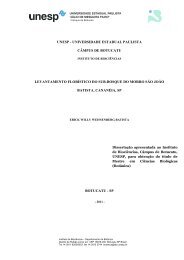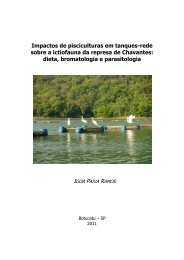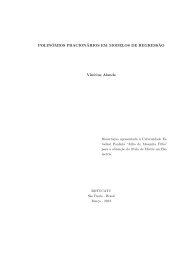Visualizar Tese - Instituto de Biociências - Unesp
Visualizar Tese - Instituto de Biociências - Unesp
Visualizar Tese - Instituto de Biociências - Unesp
Create successful ePaper yourself
Turn your PDF publications into a flip-book with our unique Google optimized e-Paper software.
Andreo Fernando Aguiarseveral mo<strong>de</strong>ls of injury and repair. IGF-I mRNA expression in SCs and proliferatingmyoblasts was increased in EDL muscle within 24 h of ischemia/reperfusion injury andpeaked at 3 days (35). In humans, eccentric contraction, which produces greater muscledamage than concentric contraction, led to greater increases in muscle IGF-I mRNAexpression (5). Although it has been well reported the important role of IGF-I inactivation of the CSs, it remains unknown whether the IGF-I contributes to musclehypertrophy induced by long-term RT. In our study, the training during 8 weeksinduced a 30.1% increase in IGF-I mRNA expression, but this increase returned tonormal levels after 12 weeks of training (Fig. 9A).The return of IGF-I mRNA expression to baseline after 12 weeks of RT isconsistent with previous studies that showed a <strong>de</strong>crease in circulating IGF-I levels at 11and 15 weeks of intense training in untrained healthy subjects (49, 51). However,studies that analyzed the local IGF-I expression during long-term resistance training<strong>de</strong>monstrated an increase in IGF-I at both the mRNA (24) and protein (53) levels.Although contradictory results have been obtained in previous studies, our findingstogether with others (49, 51, 53) raise important questions concerning the relativecontributions of the systemic vs. local IGF-I system to adaptations induced by chronicRT. Zanconato et al. (64) reported increase in local IGF-I gene expression <strong>de</strong>spite nochanges in circulating IGF-I was observed after exercise training in rats. In addition,Nindl et al. (43) suggest that the circulating IGF-I levels can be influenced by the <strong>de</strong>greeof tissue sequestration of IGF-I from the systemic circulation. Despite the <strong>de</strong>creasedIGF-I mRNA expression in the current study, it is important to note that the long-termRT induced improvements in physical performance outcomes (i.e., increase of strength,fiber IIX/D-to-IIA types transition and increase of muscle fibers CSA). Thus, it appearsthat favorable neuromuscular anabolic adaptations can occur <strong>de</strong>spite of IGF-I geneexpression returned to baseline during long-term RT More studies, particularly inhealthy subjects, are nee<strong>de</strong>d to concomitantly quantify both local and systemic IGF-I inor<strong>de</strong>r to clarify the relative roles of IGF-I in mediating long-term RT adaptations.Hypertrophy stagnation. In the current study, the hypertrophy response showedstagnation between 8 and 12 weeks of training (Fig. 6E), while the absolute and relativemuscle strength was markedly increased (Fig. 5). Consi<strong>de</strong>ring that the MRFs wereupregulated during RT program, why hypertrophic response showed stagnation duringthe time course of resistance training program? There are two possibilities that mightexplain this paradox. First, if the myogenin and MyoD regulate the hypertrophy, the65
















